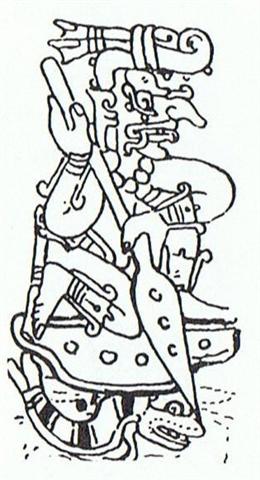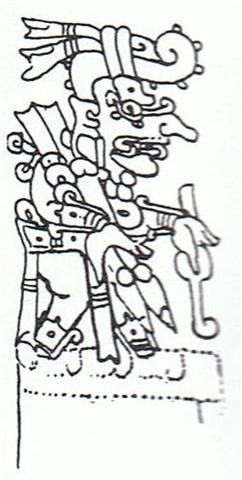Let's try to insert the explorers' dates according to my tentative interpretation of Manuscript E:
| 'February 23 (54) |
24 |
25 |
22 |
| He Anakena 23 |
24 |
25 |
| no glyph |
 |
 |
| Ca1-1 |
Ca1-2 |
| koia |
ki te hoea |
| Al Fargh al Thāni-25 / Uttara Bhādrapadā-27 / Wall-14 |
χ Pegasi (340.4), θ Andromedae (341.0) |
| Caph, SIRRAH (338.8), ε Phoenicis (339.1) |
ALGENIB PEGASI (340.0) |
| Alchita, Ma Wei (156.1), Minkar (156.7), ρ Centauri (156.9) |
Pálida (157.6), Megrez (157.9) |
Hasta-13 / Chariot-28 |
| GIENAH (158.1), ε Muscae (158.2), ζ Crucis (158.4), Zaniah (158.9) |
| 'March 19 |
20 (80) |
0h (365.25) |
21 |
| Hora iti 19 |
20 |
21 |
 |
 |
 |
| Ca1-25 |
Ca1-26 |
Ca2-1 (27) |
| kiore ki te huaga |
kua moe ki te tai. |
Te heke |
| no star listed |
ANA-NIA |
Al Sharatain-1 / Ashvini-1 / Bond-16 |
| POLARIS, Baten Kaitos (364.8), Metallah (365.1) |
Segin, Mesarthim, ψ Phoenicis (0.2), SHERATAN, φ Phoenicis (0.4) |
| τ Bootis (181.2), Benetnash (181.5), ν Centauri (181.7), μ Centauri, υ Bootis (181.8) |
no star listed |
12h (182.6) |
Muphrid (183.1), ζ Centauri (183.3) |
| 'March 22 |
23 |
24 (84) |
25 |
26 |
| Hora iti 22 |
23 |
24 |
25 |
26 |
 |
 |
 |
 |
 |
| Ca2-2 |
Ca2-3 |
Ca2-4 (30) |
Ca2-5 |
Ca2-6 |
| erua tagata |
te henua |
tagata oho ki tona huaga |
kua oho |
| ι Arietis (1.0), λ Arietis (1.2) |
Alrisha, χ Phoenicis (2.2), Alamak (22.7) |
κ Arietis (3.3), Hamal (3.5)
Alkes
|
η Arietis (4.9) |
no star listed |
| φ Centauri (184.0), υ¹ Centauri (184.1), υ² Centauri (184.8), τ Virginis (184.9) |
Agena (185.1), θ Apodis (185.5), Thuban (185.8) |
χ Centauri (186.0), Menkent (186.1) |
Neck-2 |
Al Ghafr-13 / Svāti-15 |
| Asellus Tertius, κ VIRGINIS, 14 Bootis (187.8) |
15 Bootis (188.2), ARCTURUS (188.4), Asellus Secundus (188.5), SYRMA, λ Bootis (188.6), η Apodis (188.8) |
Asellus Primus is θ Bootis, which might explain the tara glyph at Ca2-8:
| Egyptian nfr |
 |
Phoenician teth |
 |
Greek theta |
Θ (θ) |
|
... The form of the letter θ suggests a midline ('waist'), although the origin of θ is the Phoenician tēth which means 'wheel'. This in turn could have originated from a glyph named 'good' which in Egypt was nfr ...
... θ is the last star in the Ara constellation, and the ancient meaning of this letter was described as a wheel by the Phoenicians but for the Egyptian it meant 'good. When the wheel of time has come full cycle around and the upside down fire-altar is in the past the times ahead should be good (or lucky Sa'ad) ... |
The time order is reversed from Asellus Tertius to Asellus Primus and beyond Hora iti 29 (in Manuscript E) there is no longer any sequence of definite dates:
|
Arrrival at Rangi Meamea |
He Anakena 23 |
53 |
28 |
|
Stay at Oromanga |
- |
53 + 28 = 81 |
|
Departure for Papa O Pea |
Hora iti 20 |
|
Stay at Papa O Pea |
- |
81 + 6 = 87 |
|
Departure for Ahu Akapu |
Hora iti 26 |
|
Stay at Ahu Akapu |
- |
87 + 3 = 90 |
|
Departure for Pu Pakakina |
Hora iti 29 |
|
|
|
Stay at Pu Pakakina |
- |
etahi marama |
59 (?) |
|
Departure for yam plantation |
Hora nui 1 |
- |
|
Stay at yam plantation |
- |
etahi marama |
As a further Sign the date Hora nui 1 is an obvious contradiction to the flow of time past Hora iti 29 - more than one month (etahi marama) earlier. Is there some kind of jump in calendar time here? A jump which will bring us from the end of 'March to the end of 'April?
I think the explanation could have something to do with the 'Covering' (Al Ghafr), the 13th Arab manzil, which was visible in the night sky. Possibly at the opposite side of the sky it was the time of 'uncovering', coming forth. To enable the Sun King to take his residence at Hanga Moria One:
|
1
Te Manavai |
2
Te Kioe Uri |
3 Te Piringa Aniva |
|
4 |
Te
Pei |
10 |
Tama (*) |
16 |
Mahatua |
|
5 |
Te Pou |
11 |
One
Tea (†) |
17 |
Taharoa |
|
6 |
Hua Reva |
12 |
Hanga Takaure |
18 |
Hanga Hoonu |
|
7 |
Akahanga (†) |
13 |
Poike |
19 |
Rangi Meamea |
|
8 |
Hatinga Te Kohe |
14 |
Pua Katiki |
20 |
Peke Tau O Hiti |
|
9 |
Roto Iri Are |
15 |
Maunga Teatea |
21 |
Maunga Hau Epa |
|
22 |
Oromanga |
23 |
Hanga Moria One |
24 |
Papa O Pea |
25 |
Ahu
Akapu |
|
birthplace of the new king |
residence of the current king |
residence for the future king |
residence for the abdicated king |
|
26 Te Pito O Te Kainga |
Tagata in Ca2-9 could have his hands up in a
'cloud cover', making them invisible. From these clouds the 'Bull'
(the spring Sun king) would eventually break through:
|
Explorers greet Hotu Matua |
Tangaroa uri 15 |
|
Departure of the explorers for Hiva |
Tangaroa uri 20 |
North of the equator the Rain God first sailed across the horizontal Sea, then came down the slope from the clouds and landed on the surface of the Earth, imprinting his presence:
  
|











